Removal Procedure
- Raise and suitably support the vehicle. Refer to
Lifting and Jacking the Vehicle
in General Information.
- Remove the left front tire and wheel assembly. Refer to
Tire and Wheel Removal and Installation
in Tires and Wheels.
- Move the steering shaft dust seal to gain access to the pinch
bolt. Refer to
Steering Gear Replacement
in Power Steering.
Caution: Failure to disconnect intermediate shaft from rack and pinion stub shaft
can result in damage to steering gear and/or intermediate shaft. This damage
can cause loss of steering control which could result in personal injury.
- Remove the lower pinch bolt from the intermediate steering shaft. Refer
to
Steering Gear Replacement
in Power Steering.
- Loosen all the insulator clamp attaching nuts and bolts.
- Place a jackstand under the center of the rear frame crossmember.
- Turn the two front frame-to-body bolts four revolutions to loosen.
- Remove the two rear frame-to-body bolts.

- Remove the two insulator
clamp bolts for the front suspension stabilizer shaft without FE3 or F41 suspension.

- Remove the two insulator
clamp nuts and bolts for the front suspension stabilizer shaft with FE3 or
F41 suspension.
- Lower the rear of the frame just enough to gain access to the
stabilizer shaft.
- Remove the insulators and remove the clamps from the frame and
the control arms.
- Perform the following steps to remove the stabilizer shaft:
| 13.1. | Pull the stabilizer shaft rearward. |
| 13.2. | Swing the stabilizer shaft down. |
| 13.3. | Remove the stabilizer shaft from the left wheelhouse of the vehicle. |
Installation Procedure

- Install the stabilizer
shaft from the left wheelhouse of the vehicle.
- Coat the new insulators with rubber lubricant.
- Install the new insulators.
- Loosely install the clamp at the control arm.
Notice: Use the correct fastener in the correct location. Replacement fasteners
must be the correct part number for that application. Fasteners requiring
replacement or fasteners requiring the use of thread locking compound or sealant
are identified in the service procedure. Do not use paints, lubricants, or
corrosion inhibitors on fasteners or fastener joint surfaces unless specified.
These coatings affect fastener torque and joint clamping force and may damage
the fastener. Use the correct tightening sequence and specifications when
installing fasteners in order to avoid damage to parts and systems.
- Loosely install
the clamp and bracket bolts to the frame.
Tighten
| • | Tighten the clamp to frame nuts/bolts to 47 N·m (35 lb ft)
on the 28 mm and the 30 mm shafts. With FE3 or F41. |
| • | Tighten the bracket to frame nuts to 37 N·m (27 lb ft)
on 34 mm shaft. Without FE3 or F41. |
| • | Tighten the clamp to lower control arm bolts to 47 N·m
(35 lb ft). |
- Raise the frame into position while guiding the steering shaft
into the gear.
- Install the new frame-to-body attaching bolts. Refer to
Frame Removal
in Frame and Underbody.
- Remove the jackstand.
Caution: When installing the intermediate shaft make sure that the shaft is seated
prior to pinch bolt installation. If the pinch bolt is inserted into the coupling
before shaft installation, the two mating shafts may disengage. Disengagement
of the two mating shafts will cause loss of steering control which could result
in personal injury.
- Install the intermediate shaft and tighten the pinch bolt. Refer to
Intermediate Steering Shaft Replacement
in Steering Wheel and Column.
- Install the tire and wheel assembly. Refer to
Tire and Wheel Removal and Installation
in Tires
and Wheels.
- Lower the vehicle.



